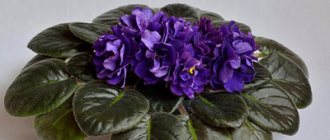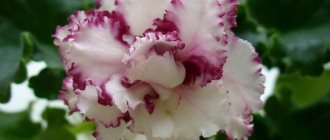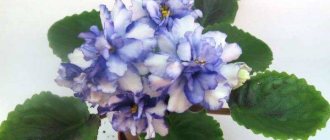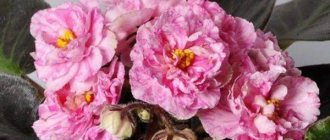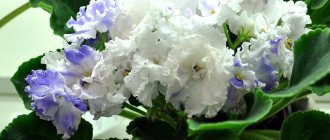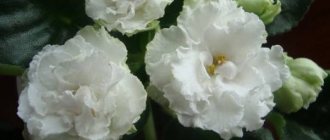Female names work well for different flowers, and it is therefore rare to find a species that does not have at least one variety with a similar name.
a very common practice for indoor violets ; sometimes even several varieties bred by different gardeners can have the same name.
About two such varieties with the beautiful name Magdalene violet (ND, RS).
About all the nuances of care, differences between varieties. If you make mistakes in some points, you can either get a specimen that does not correspond to the variety , or even destroy the flower.
Ice Rose
“Ice Rose” is a variety that can decorate the collection of any amateur gardener.
Quite large double flowers with a corrugated edge against the background of dense bright green leaves look almost weightless. Distinctive features of the variety are:
- A wide rosette reaching a diameter of 4 cm. This point should definitely be taken into account when choosing a pot for violets.
- The ability to change the shade of flowers from flowering to flowering. From white with small splashes of lilac, the tone turns into crimson with a light border.
- Large sheet size. The length can reach 12-15 cm.
- With moderate lighting and fertile soil, up to 8 flowers can appear on one bush.
Isadora
Naming a violet after the famous dancer Isadora Duncan is the right decision. In originality, beauty and grace, the plant is in no way inferior to its famous namesake.
Lush, airy flowers are painted soft pink or white and strewn with bright lilac spots. The leaves are heart-shaped and rich green in color. The Isadora rosette is small. Each peduncle grows up to 6 buds, which bloom within 2-3 weeks.
Like most violets, Isadora loves moisture and is skeptical about direct sunlight. For breeding, you will have to find a place on the western, eastern or southeastern side of the house away from drafts.
Caring for a plant at home
Conditions of detention
Both varieties are standard violets , medium in size, and therefore their maintenance conditions are almost the same. And small differences should be observed only to obtain exhibition or ideal bushes.
The main points when choosing a place to grow violets are:
- Lighting;
- Temperature;
- Humidity.
Each point is important in its own way, and only together they guarantee proper development and flowering:
- The light should be bright , but without direct sunlight. The varieties also perform well under artificial light. The duration of daylight in natural light depends on the season, but it is recommended to maintain 12-13 hours year-round, this is possible with the help of additional lighting or a complete switch to lamps;
- It is also recommended to maintain the temperature stable throughout the year. The temperature should be on average 22-24°C. If the temperature changes seasonally, then it ranges from 16-18° to 24-26°, in winter and summer, respectively;
- Air humidity - this indicator fluctuates in accordance with temperature. The higher the indicator on the thermometer rises, the higher the % humidity in the room should be.
Choosing the right place is one of the main points to achieve a beautiful representative of Saintpaulia.
Watering and fertilizing
Water and minerals are the basis for the growth and development of a flower . These varieties respond well to both classical watering methods and wicking.
Violets can be watered in the usual way.
To obtain a well-developed and blooming rosette, it is important to follow the watering and fertilizing schedule:
- Classic (in a tray and under sheets) - the procedure is carried out as needed, about once a week (in summer, less often in winter). Fertilizers are applied through irrigation, in a concentration that is half the recommended;
- Wick (through a wick from the lower container) - water is always in the container under the flowerpot, and minerals are constantly added to the water, but the dosage is reduced by 7-8 times.
Transplantation, rejuvenation, pruning
Like all standards, these varieties need to be pruned regularly , removing old leaves and flower stalks.
Attention! For the correct formation of the PC-Magdalena rosette, it must be well trimmed, removing the lower elongated leaves.
For good development it is necessary to replant the bush regularly . In youth, the bushes are replanted as they grow, increasing the size of the flowerpot.
Adult bushes do not need to be replanted so often; once a year or even two is enough for them.
The soil is selected ready for Saintpaulia, or prepared depending on the type of irrigation.
During planned transplants, the plant is pruned , removing several rows of leaves and dead roots. This way the bush is rejuvenated.
Reproduction
Both varieties do not have features that would limit the methods of propagation:
- Leaf cuttings - root a leaf from 2-3 rows, in the way that the grower prefers: in soil, water or moss;
- Stepchildren - planted at different ages, with native roots or rooted like leaves;
- Peduncles - root only in the ground, under the film.
Violets are most often propagated by leaves.
The bride's bouquet
The “bridal bouquet” violet is easily recognized by its double, snow-white inflorescences with a wavy edge. The variety's rosette is compact and forms an almost perfect circle. The leaves are dense, dark green.
With long daylight hours, regular watering and comfortable temperatures, the “bridal bouquet” can bloom all year round. The plant grows quickly, so an adult violet will have to be replanted every 6-7 months.
Violet ND-Magdalene (N. Danilova-Suvorova)
Rich in color, large, unusually bright flowers of ND-Magdalena (N. Danilova-Suvorova) rise with a neat cap above an even rosette - even and obedient.
A magnificent bush attracts the eye and stands out among others! It is worth noting that this is a worthy variety also because the flowers do not fade over time. They hold their color fast.
Violet ND-Magdalene: description
ND-Magdalena variety is a genus of hybrid Saintpaulias. Family: Gesneriaceae. Has a standard size and type of socket.
The leaves are round in shape with small teeth along the edges and a heart-shaped base. Uniform, uniform color of dark green leaves with clear veins. The underside of the leaf plate is red.
The cuttings are strong and short, but very succulent, which makes them fragile.
Large flowers - semi-double and double. There is a smooth flounce along the edge of the petals. The color is fantasy. A raspberry tone with a bright tint is the main one. A scattering of purple dots, like splashes, are scattered across the petals closer to the edge. Their number increases in a wave, moving towards the edge, forming a wide, impressive border.
We would like to warn you that the border or coating of the ND-Magdalena is sometimes absent. But there are cases when they swim in a dark spot.
Features of growth, flowering and reproduction
The variety is good in active growth and development. An adult rosette is received within 10-12 months. It can bloom in adolescence (at 9-10 months, less often at 8 months).
Flowering is abundant.
Peduncles : low, plump and strong. On average, up to 5 buds are laid.
Large crimson and fantasy flowers cover the entire rosette with a cap (cap bloom). The buds last for at least 7 days.
Temperature conditions for ND-Magdalene
When the ambient temperature changes, the color of the flower also changes.
During the period of bud formation when the temperature rises:
- the color darkens;
- the number of dark spots increases;
- the petals may completely darken, and only a light spot will remain in the center.
When the temperature drops:
- the percentage of light color increases;
- the dark border-spray completely disappears;
- Only rare dots may remain along the edge.
variety (N. Danilova-Suvorova) is propagated using the following methods.
- Leaf cuttings.
- Stepsons.
- Peduncles are used in the absence of high-quality material for the first two points, more often to preserve unusual flowering in the child.
- The seeds are used to breed new varieties (they are ineffective for conventional propagation).
Wick watering is more suitable for violets. The leaves become more powerful, the cuttings thicken. Flowers increase in size and number.
Large semi-double deep pink flowers with a wavy crimson edge. 2016
NK-Magdalene sports were recorded. The shape and color of the flower may change slightly.
Buy violet NK-Magdalena
order the ND-Magdalina (N. Danilova-Suvorova) variety on our website in the online store. Here you will also purchase related products: containers for seedlings and fertilizers.
Rosemary
Due to their splendor, rosemary buds resemble bright pompoms with a diameter of up to 6 cm. Peduncles, consisting of 3-4 ovaries, are located in the center of a large rosette. The diameter of an adult bush reaches 32-35 cm.
The coloring is considered one of the most elegant. White-pink petals are densely strewn with purple splashes and stains. The core is bright yellow. In summer, the whiteness almost completely disappears, and returns again as the temperature drops.
Birth of love
The “Birth of Love” variety, bred by breeder E. Korshunova, fully lives up to its name. The flowers are unusually delicate, airy, and the aroma is light and fresh.
The color of the petals smoothly transitions from white to light pink. The edge is framed by a wavy border. The inflorescences are arranged in a lush cap and can completely cover an unattractive, at first glance, rosette.
Gray Ocean
Abundant clusters of large spherical “gray ocean” inflorescences decorating a small rosette have made this variety one of the most desirable in the collection of every plant grower. Densely double flowers are distinguished by a gradient color, turning from white to dark purple. The leaves are neat and even.
Many housewives note that a young violet has a lighter color, but over time, the “gray ocean” can completely darken and turn into a “Black Pearl”. To prevent this from happening, you should periodically update the plant by rooting a light leaf from the rosette.
Currant dessert
“Currant dessert” violets will appeal to lovers of deep, rich flowers. The leaves are velvety, the flowers are double or semi-double, dark purple. The shape of the inflorescences resembles small stars with a diameter of 6-7 cm.
Despite the visual appeal, the variety is considered one of the most unpretentious. Even novice gardeners can grow a “currant dessert”.
Magdalene
“Magdalene” amazes with its sophistication, splendor, and delicacy. This name hides two similar varieties, but bred by different breeders.
“ND-Magdalena” by N. Danilova-Suvorova is distinguished by dark green, rounded leaves with fine serrations along the edge and crimson flowers. Up to 5 buds are formed on the peduncles, which during the period of abundant flowering cover the rosette with a lush “cap”. As the temperature drops, the main color of the petals becomes lighter, and small purple ripples become noticeable along the edges.
“RS-Magdalene” by S. Repkina has a similar shape, but lighter foliage. The color of the flowers is more delicate, closer to pink. The color does not change with temperature changes and remains saturated even in hot months.
Violet ND-Magdalene: photo and description
The ND-Magdalena variety belongs to the genus of hybrid Saintpaulias from the Gesneriev family . Bred by breeder N. Danilova-Suvorova, and has a standard size and type of rosette.
The ND-Magdalina variety was bred by breeder N. Danilova-Suvorova.
The leaves are round, have small teeth along the edge and a heart-shaped base. The cuttings are short, strong, succulent and therefore quite fragile. The color of the sheets is uniform, monochromatic, dark green with a red underside and a clear imprint of veins.
The flowers are large, double and semi-double with a wavy edge of the petals. The color is fancy, the main tone is raspberry , a bright shade. Closer to the edge, purple dots are scattered along the petal, like splashes, the number of which increases as you move towards the edge, where they form a continuous, rather wide border.
NK-Magdalena has no recorded , but sometimes sports occur. The flower shape and color may change slightly.
Important! There may be no coating or border, or, conversely, it may be completely covered in a dark color, without a light part.
Features of flowering, growth and reproduction
The variety grows and develops well; in 10-12 months you can get an adult rosette . The first flowering occurs in adolescence, at about 9-10 months, sometimes 8.
Flowering is abundant, and flower stalks :
- Sturdy;
- And short;
- Quite thick.
On average, from 2 to 5 buds are laid on each. The flowers are large and cover almost the entire rosette, so it can be called a cap type. The buds last well, on average up to a week.
Depending on the temperature, the color of flowering may change. the room temperature rises during bud laying :
- The color darkens;
- The number of dark spots increases;
- Sometimes the flowers may darken completely, leaving only a light spot in the center.
Reducing the temperature is the opposite:
- Increases the percentage of light;
- And the dark border-spray may completely disappear;
- Or only rare dots remain along the edge.
Considering the color of the leaves and flowers, this variety is propagated by any available method .
Most often, leaf cuttings and stepsons are used; flower stalks are used:
- In the absence of satisfactory material for the first two points;
- Or to preserve unusual flowering in the baby.
New varieties are usually bred by seeds , but for ordinary propagation it is not very effective.
Reviews
Igor. “I’ve wanted this variety for a long time, and then a chance came up, and I bought a flowering bush. For quite a long time he pleased me with flowers. After a while, I switched it to wick watering and the bush pleased me even more. The leaves became more powerful, slightly larger, and the cuttings became thicker. The first flowering on the wick was also pleasing. The flowers have become larger, and their number is pleasantly surprising.”
The ND-Magdalene violet has an unusual flower color.
Natalia. “After buying the baby, I couldn’t wait for it to bloom. Every day I looked closely at the outlet, and when I saw the first flower stalk, I was incredibly happy. The flowers did not disappoint; their size and color pleased the eye for quite a long time. The variety is not fussy to care for, at least I didn’t have any problems with it. And it’s easy to propagate; each leaf produces 2-3 babies.”
Villodene
If most violets acquire a special decorative effect only with the beginning of flowering, then “villaden”, thanks to the unusual color of the leaves, stands out even in the absence of ovaries.
Distinctive features of the variety:
- Wide, reaching a diameter of 45 cm, rosette;
- Simple pink or peach flowers with a wavy edge that may turn slightly green as temperatures drop;
- Large leaves of variegated, white-green colors.
“Villodene” does not bloom as profusely as other varieties, so it is grown exclusively for its decorative rosette.
Violet RS-Magdalene
The variety belongs to the genus of hybrid violets, from the Gesneriev family, like all modern varieties of indoor violets. The variety was developed by breeder S. Repkina.
The rosette is of standard size, very neat, but when young it has slightly elongated petioles . Leaves:
- Medium green;
- Standard size;
- Rounded with small teeth along the edge.
Violet PC-Magdalene has lush flowers.
The flowers are large, very double, like balls with a wavy edge of the petals. The color is pink, very delicate, and at the same time rich. The peduncles are strong and thick, stretch straight up, forming a beautiful bouquet.
No sports have been recorded, but perhaps they are simply not officially registered .
Features of flowering, growth and reproduction
The rosette grows very quickly, and develops very well with natural lightening ; under lamps it grows more slowly. The rosette matures at the age of 11-13 months, but blooms earlier. And it blooms profusely the first time, forming many flower stalks.
Flowering is abundant, on strong, thick peduncles with 3-5 buds on each. The size of the flowers is very large , and their number completely covers the center of the rosette, and sometimes the whole thing, forming a large bouquet-cap.
The color of the flowers almost does not change with temperature changes, and do not fade in summer.
Attention! The buds bloom for a very long time, up to 10 days, and a large number of gradually opening flowers ensures long flowering.
Reviews
Anastasia. “I bought a violet RS-Magdalena, it was a starter, and pretty soon it grew up. The first flowering made me very happy, even a little shocked, it was so abundant. Huge flowers, like balls, sometimes you can’t even believe that they are real, and they form a large bouquet at the top, which sometimes also resembles a big furry ball.”
Violet RS-Magdalene has many positive reviews from gardeners.
Hope. “A friend, breeding her beauty, gave me a baby. It grows and forms very well on my western window. After some time, she got sick with me, unfortunately, then I lost a lot of children. After recovery, she grew more slowly, but the wait was worth it. Incomparable flowers form an amazing bouquet.”
Avatar
The Avatar violet is beautiful in its simplicity and sophistication. The variety belongs to the miniature category, so even those with narrow window sills can grow it.
The shape of the flowers is more reminiscent of forest bells and has a diameter of up to 2.5 cm. The color is plain, dark blue or purple. With abundant flowering, a scattering of buds completely covers a small rosette.
The violet has long moved from the category of an ordinary houseplant to a symbol of home comfort and warmth. And from a huge number of varieties, every gardener will be able to find exactly the one that will amaze him with its color, shape or foliage.
Varieties by Svetlana Repkina - Aristocrat, Ballerina, Goddess Aurora, Indonesia
And now I will tell you about my favorite varieties. I have many favorites, but I want to start with the varieties of Svetlana Repkina. I will show you just a few of its varieties. To make it easier for you to watch, I will break it into 2 messages.
1. PC-Aristocrat. This is a real aristocrat. She always keeps her mark both in the dark and in the light.
2. RS-Ballerina. Another white girl. She has a more lacy flower than the Aristocrat and a more slender rosette.
3. RS-Snow in April. Another white violet. She was the very first white one to bloom for me. Although she cannot be classified as pure white. It has a bluish glow coming from the center. And it seems that these balls of snow lay on the emerald leaves.
4. PC-Goddess Aurora. This girl also bloomed early, but it was so uninteresting and pale that it was a miracle that she didn’t fly into the bucket. Then it went through a hard winter, and all that was left was a stalk with four leaves. I didn't even expect it to bloom. And it bloomed so brightly that I literally opened my mouth.
5. RS-Harmony. I love pink ones. This girl bloomed early. And then a long break in flowering. Whatever I didn’t do. All are blooming, but this one stands with a beautiful rosette and does not bloom at all. She took her out onto the balcony and placed her on the very top. And here it bloomed.
6. PC-Demon. This is an amazing plant. Bloomed for the first time. The rosette is beautiful, the flowers are dark blue and there is no frill or the promised ink stains. “Sports,” I decided and put it in the trash can. And after a couple of days, ink stains appeared on the flower and the shape of a flower of rare beauty began to appear. Now a favorite. But my husband, while nailing another shelf on the balcony, dropped my pet and broke it. I had to remove all the beauty and urgently replant it. Now I go and check if my Demon is alive.
7. RS-Wonderful dream. This is a hard worker. We bloom always and everywhere, despite falling off the shelves. She tore off the buds, deciding that it was enough to bloom, it was time to rest, and she released new ones again. In a word, a wonderful dream.
8. RS-Indonesia. No comments here. A little girl, but a bloomer. And we bloomed for a long, long time. I had to pick off the flowers so I could rest.
The photos of Repkina’s varieties I saw on the Internet literally shocked me. That’s why I literally bought all the varieties I found. Some with cuttings, some with children. The cuttings surprised me with their love of life - they took root quickly and produced babies just as quickly. And what beautiful children climbed! Before this, first one leaf came out, then another, but here... right away with the head. Then they started to bloom for me. My God! What a beauty!
Over time, some Repkina varieties left my collection for various reasons. But she brought out a characteristic feature of S. Repkina’s varieties. They are characterized by neat rosettes and a beautiful flower shape, as well as the large size of the flowers themselves. And another important quality - they behave perfectly both on light windows and on shelves, where it’s a little dark in my place and everyone usually keeps their hands up, but not Repkina’s varieties. They are always even.
Another feature of S. Repkina’s varieties is the revelation of the variety’s potential with each flowering. In other words: if the S. Repkina variety bloomed and it did not impress you, then wait for the second and third flowering. I don't have to wait long for them.
Continuation
I continue to introduce you to the varieties of my favorite breeder.
1. RS-Cassandra. This girl is very young and bloomed for the first time. The flower grows in size every day. I wonder how big he can grow.
2. RS-Pretty. The variety is light and completely problem-free. When it's cloudy outside, it lifts your spirits with its blooms.
3. RS-Mavka. I won't comment here. All I can say is - I love it!
4. RS-Magdalene. Also no comments. See for yourself.
5. PC-Magic Carmen. I was pleasantly surprised by its flowering. And the desire to bloom.
6. RS-Mary. Huge flowers of an unusual cherry-lilac color. Each peduncle has 5 buds.
7. RS-Natalie. Here we still haven’t come to a common opinion - I have a sport or not. According to the variety there should be a cherry coating. My flowers open with a coating, but they stand on the balcony and the coating quickly disappears. That’s why I’m not in a hurry to write sports yet. The flower itself is unique - the shape of a rose and the petals are like suede - the same velvety and heterogeneous structure.
8. PC-Princess Turandot. Similar to Natalie, but more lilac and the petals are simply smooth. The rosette is larger, although probably Natalie’s sister.
Well, that's probably all for now. I'm waiting for bouquets from the others. So far it is only clear that they have flourished according to the variety.
I foresee the question: are varieties with the RS prefix sporty?
I only succeeded in one sport. And then at first the violet bloomed according to its variety and bloomed beautifully all summer. Then there was stress in the winter and eventually I went into sports in the spring and never returned. I didn't have any more sports.
